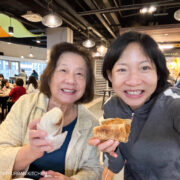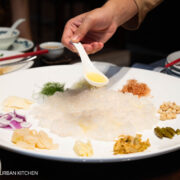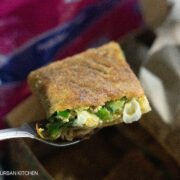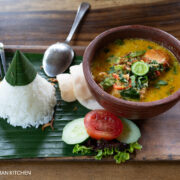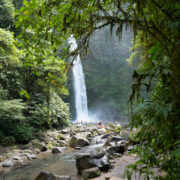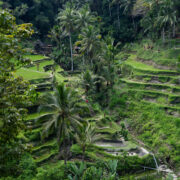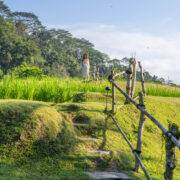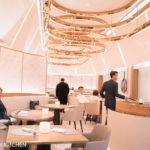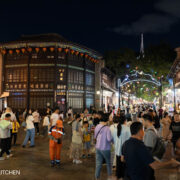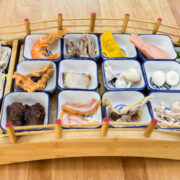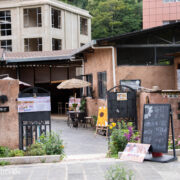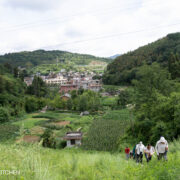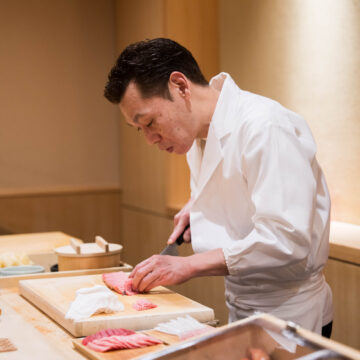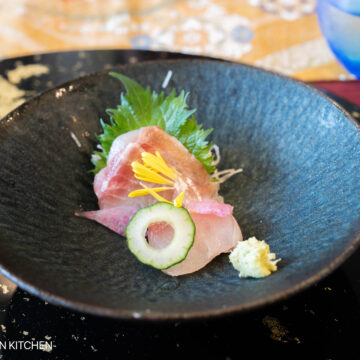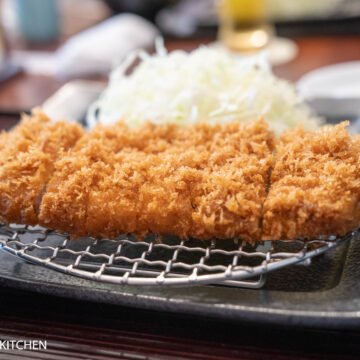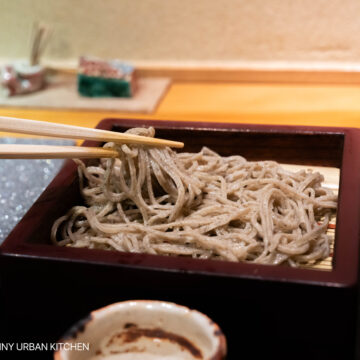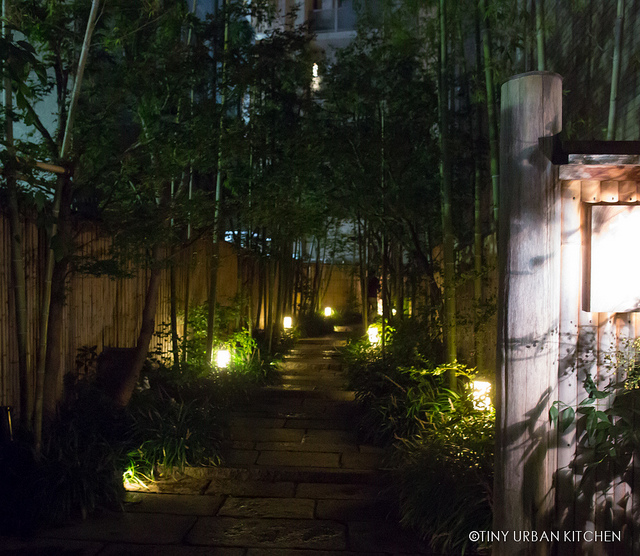
This is the first post in the series titled Tasting Tour of Tokyo detailing my recent trip to Japan.
One negative aspect of being a tag-along on your husband's business trip is that you're often alone. After all, he's in the destination to work, which means he can't hang out with you during much of the trip.
Thankfully, Tokyo is an easy city to navigate, and at this point, I know it quite well. I was perfectly happy to spend my afternoons shopping, exploring, and even visiting friends while he was at his conference.
Unfortunately, there were a few nights where he had business dinners and couldn't even eat with me.
Last time that happened, I bought simple take-out at the local depachika (basement of the department store) and ate in my hotel room. This time, I decided to head out into the city and dine solo at one of the most famous kaiseki establishments in Tokyo. 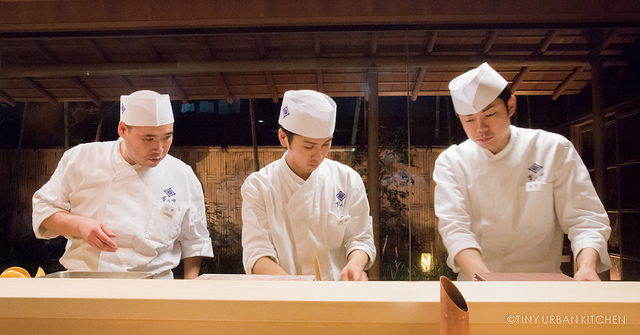
Kikunoi specializes in Japanese kaiseki cuisine, a traditional, multi-course, Japanese meal. Kaiseki meals typically involve the use of fresh, seasonal ingredients prepared in such a way as to emphasize their flavors. The entire experience is a big part of kaiseki cuisine, and therefore the ambiance of the surroundings as well as the artistic presentation of the food are also very, very important.
Kaiseki has been around for over 500 years, starting back in the 1600's when Sen no Rikyu, a tea master in Kyoto, felt that the powdered green tea used during tea ceremonies was too strong for an empty stomach, and needed some food to accompany it.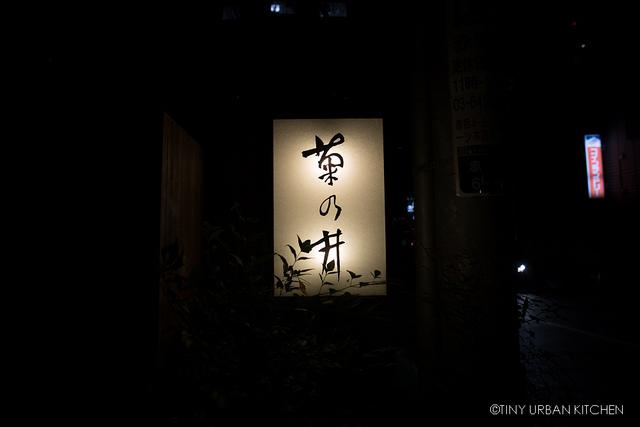
The original kaiseki meals consisted of just miso soup with three sides, but over the years they have evolved significantly, turning into one of Japan's most elaborate and high-end cuisines. Naturally, Kyoto is famous for its kaiseki cuisine, and houses some of the most famous restaurants.
Yoshihiro Murata is one of the most famous kaiseki chefs in Japan. He has his own TV show and owns three restaurants in both Kyoto and Tokyo, totaling 7 Michelin Stars.
Chef Murata practices a form of modern kaiseki that draws influence from many difference sources, such as imperial palace cuisine, the traditional tea ceremony, shojin ryori (vegetarian temple cuisine), and obanzai (traditional Kyoto cuisine that includes tofu, gluten, vegetables). Murata also derives inspiration from other well-known chefs, such as the famous Ferran Adria (with whom he is close friends) and Nobu Matsuhisa.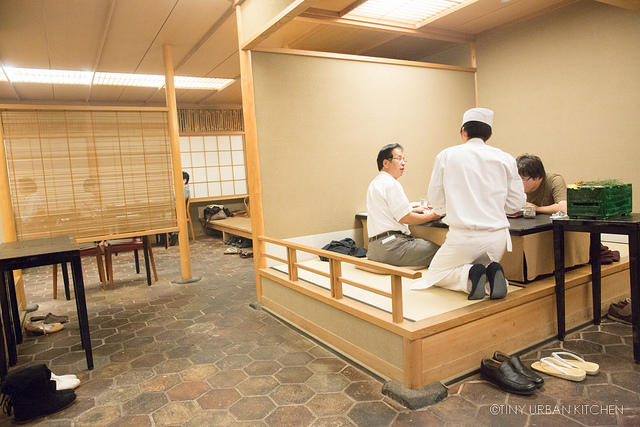
Kikunoi is Chef Murata's prized creation. The original flagship Kyoto branch (Kikunoi Honten) boasts three Michelin stars, while the other two "offshoots" (Roan Kikunoi in Kyoto and Akasaka Kikunoi in Tokyo) each have 2 Michelin stars.
Since I didn't quite have enough time to zip to Kyoto on a shinkansen (bullet train), I "settled" for the Tokyo branch in Akasaka.
Like many Japanese restaurants, Kikunoi has a bar area that makes solo dining much nicer. You can interact with the chefs and also watch them cook.
Although the staff's command of English was only so-so, they did have Chef Murata's colorful kaiseki ryori book which includes pages describing (in English!) important details about the dishes I was enjoying. Furthermore, they had English language menus, which was very helpful.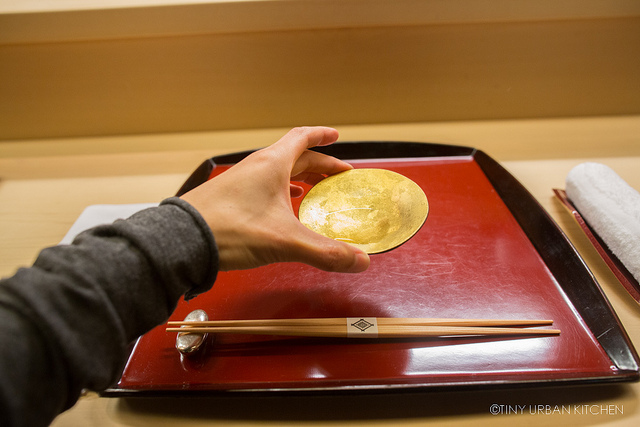
For dinner, you get a choice between three set-menus. The price difference is based on the expense of the ingredients. Matsutake mushrooms (which are very expensive) were in season during the fall, and thus set menus that included lots of the prized mushrooms naturally cost a lot more.
The prices are 15,750 yen, 18,900 yen, or 21,000 yen. Seeing how weak the US dollar is these days (about 79 yen for every US dollar) , that definitely hurts!
I went with the cheapest one, partly because it had a bit less meat and because it still focused quite strongly on matsutake mushrooms, which I love.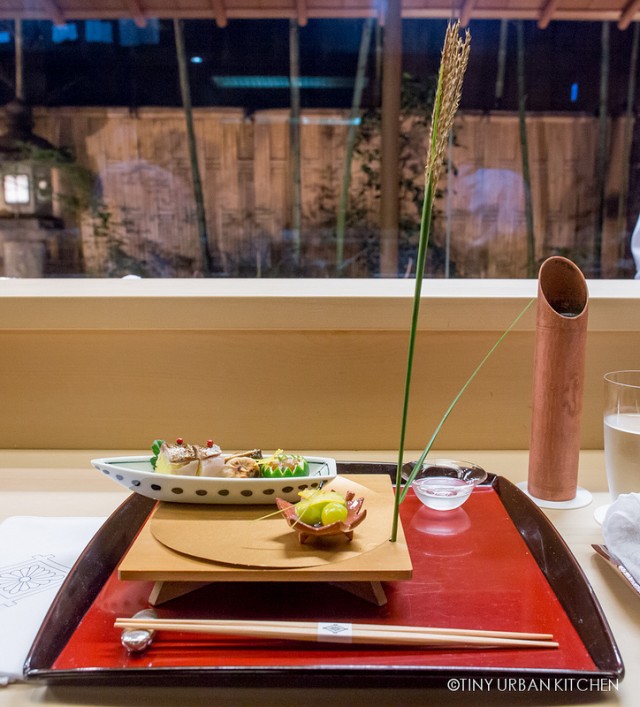
I gasped when the first course came - it was so utterly beautiful. Made to conjure up the image of one "watching the moon from a boat on a lake", this exquisite dish features many seasonal ingredients. Let's take a closer look.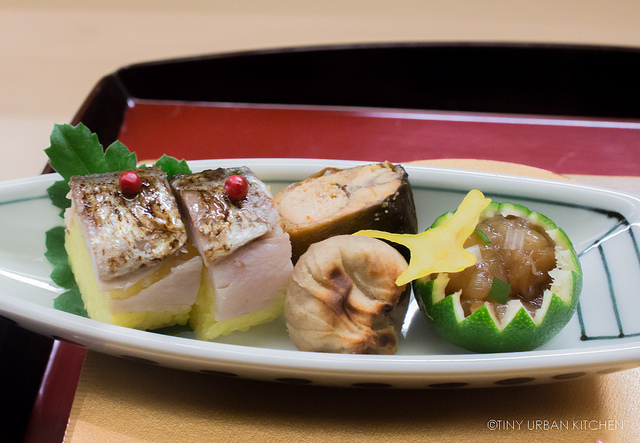
The Grilled Saury Sushi at left was topped with a strongly marinated sea bream which was quite "fishy" and salty. The single pink peppercorn on top gave the entire bite a nice "pop" of flavor that I liked. In the middle front, we have Grilled Chestnut Paste (shaped like a dumpling), while in the back we have Roe bearing Ayu (sweet fish) poached with sansho peppercorns. On the very right, a half-cut lime is filled with Prawn Marinated in Shao Xing Wine. The alcohol made the dish a bit bitter, almost boozy like Sojo.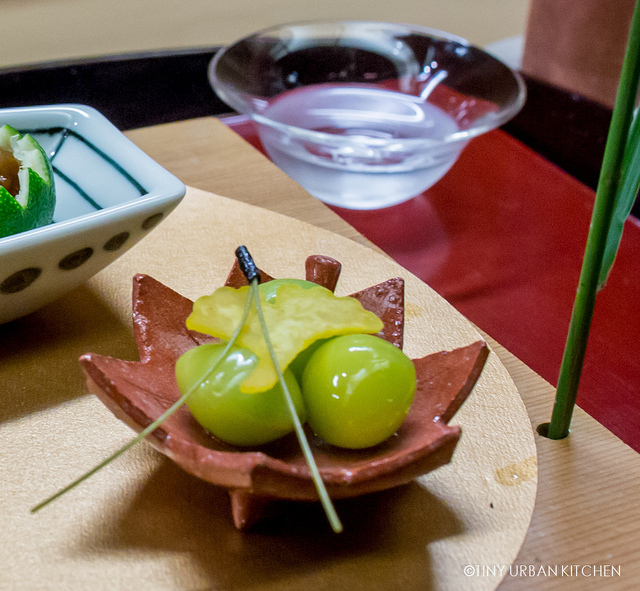
Because gingko nuts were in season, we enjoyed a small sampling of Glazed Ginko Nuts topped with a gingko-leaf shaped chip. I loved the gingko nuts. They were warm, lightly salted, and toasted with sake and salt. The intricate pine needles are actually dried green tea noodles, which surprised me with its strong tea flavor!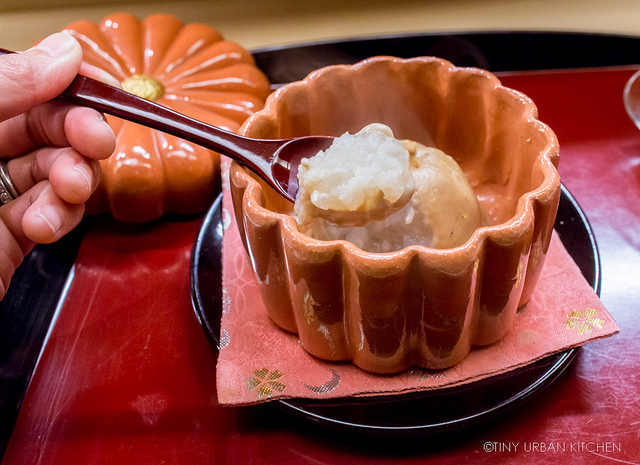
Next came the Poached Baby Kabura Turnip topped with walnut miso sauce and crushed walnuts. This local Kyoto dish is traditionally served with yuzu miso. Chef Murata's own version uses a beautiful, creamy walnut miso paste which was really, really good. Though I usually don't like walnuts, I couldn't stop eating this dish. The flavorful, umami laden miso sauce worked well to balance the light, steamed turnip, which reminded me of boiled daikon.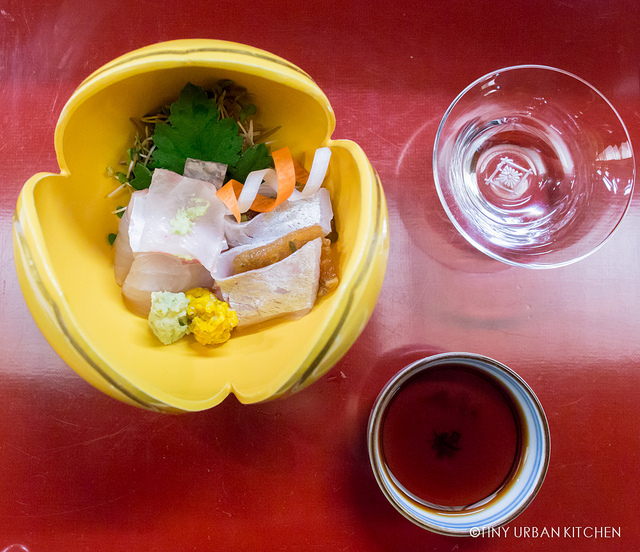
Sashimi of Butter Fish and Tai (Red Sea Bream) came with pickled chrysanthemum petals and freshly grated wasabi. The tai was chewy and had a very clean flavor. A flavorful, salty "gel" was sandwiched between one of the fish slices and added flavor to the entire dish. The pickled chrysanthemum was pleasantly not-too-sour, The texture reminded me of tiger lilies we used to eat in Chinese soups.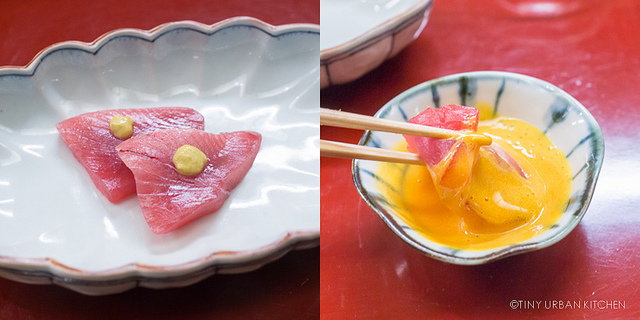
The next course was Sashimi of Koshibi (young bluefin tuna) topped with a small dab of mustard and served with a soy-marinated egg yolk sauce. The young tuna was buttery soft and picked up the thick, eggy sauce quite nicely. The flavor of this dish was excellent, although it didn't stand out as being particularly unique or unusual.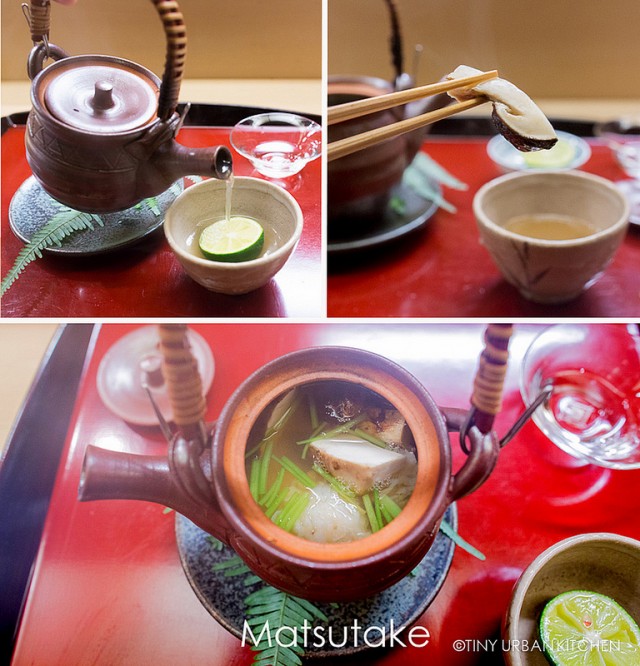
This next dish was one of my favorites all evening. Hamo (pike eel), Matsutake (pine mushroom), and Mitsuba Herb steamed in a teapot with Sudachi Lime. I love Matsutake mushrooms, and in my opinion, any broth made with these oh-so-expensive mushrooms is heavenly. The eel added needed umami to the fragrant, herbaceous broth. After slowly savoring the golden elixir sip by sip, I opened up the tea pot and ate all the mushrooms inside. The Sudachi lime added a nice, bright citrusy splash to the strong savory notes of the dish (though I don't think I was supposed to pour the tea over the lime - oops!).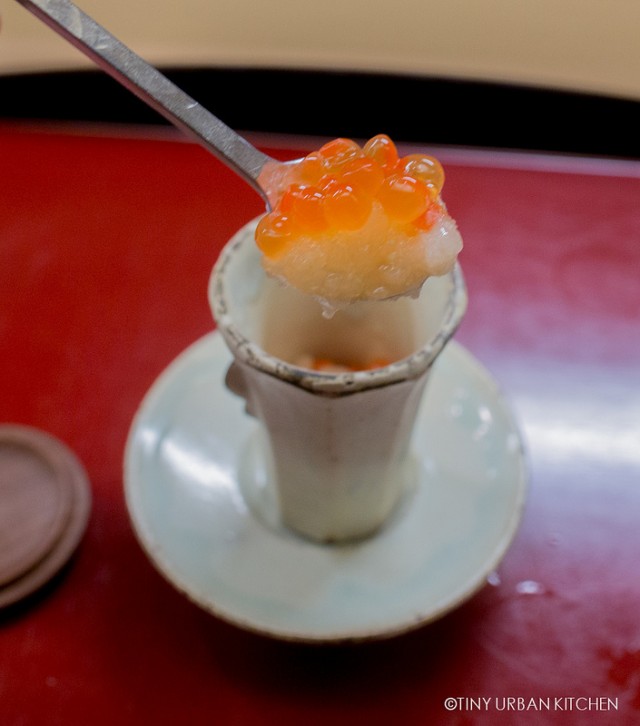
The next bite, Salmon Roe with Grated Radish, sounds simple yet was surprisingly really, really good. The slight bitterness of the daikon was nicely balanced by the briny roe.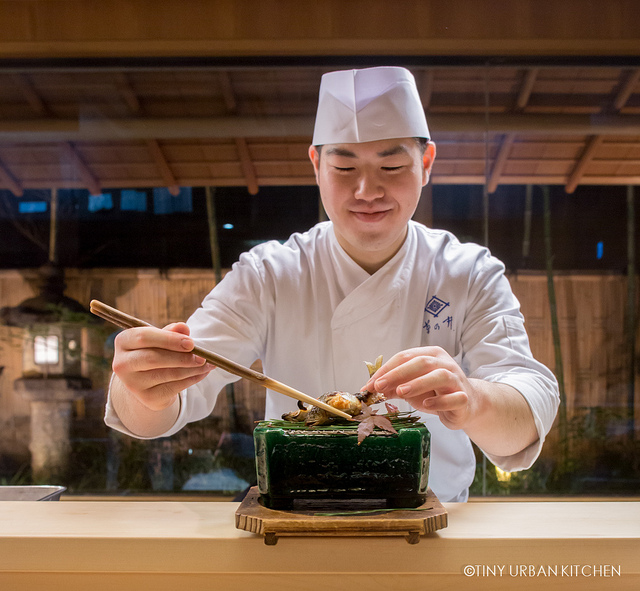
At this point I was already getting really, really stuffed. Honestly, I almost groaned when I saw the next dish - two whole Salt-Grilled Ayu (Sweetfish) with Roe. Nevertheless, I had to admit it was an absolutely beautiful presentation.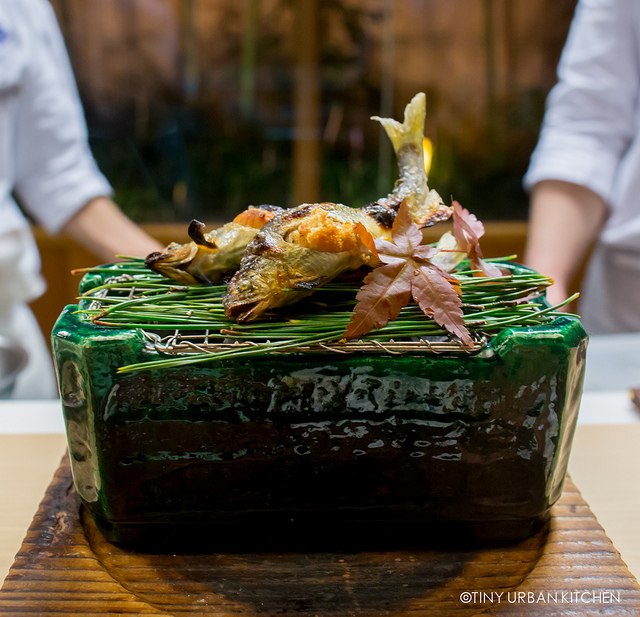
The chef placed two perfectly grilled fish, sliced so that the roe was spilling out, onto a bed of pine (?) needles and autumn leaves.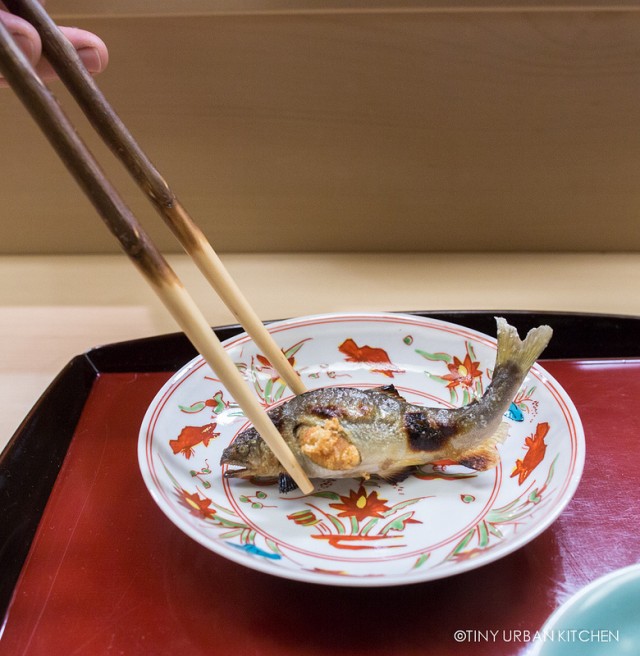
I was definitely a bit squeamish about eating a whole fish. I had watched the Japanese ladies to my right eat this, and they polished the entire thing off -head and all! At the end, I couldn't bear to eat those eyes staring at me, so I left the head.
Objectively, the dish was perfectly executed. The fish nicely grilled with a gorgeous char and a crispy tail. Although it was tasty, the dish didn't strike me as mind-blowing (though, to be fair, I was getting stuffed at this point).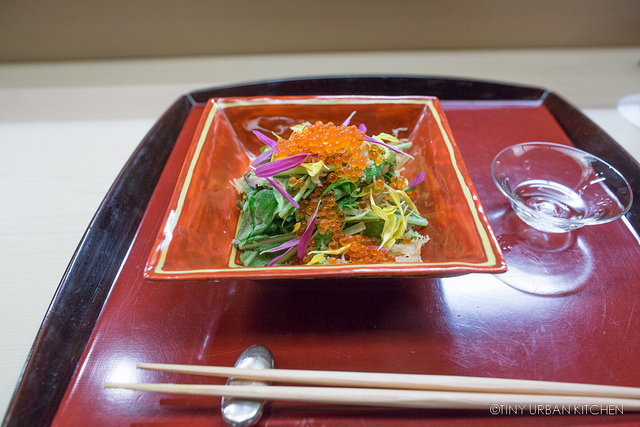
Almost like a break, the next course was refreshingly light, a salad filled with Mibuna Greens (A variety of mizuna), Grilled Shitake Mushrooms, Grilled Maitake (Hen of the Woods) Mushroom, and Trout Roe tossed together in a sasame and ponzu dressing. Edible flowers completed the colorful display.
I really liked the use of bonito flakes, which add a bit of umami to the very leafy salad. The flavors were nice, though the salad did not quite strike me as a Michelin-level dish.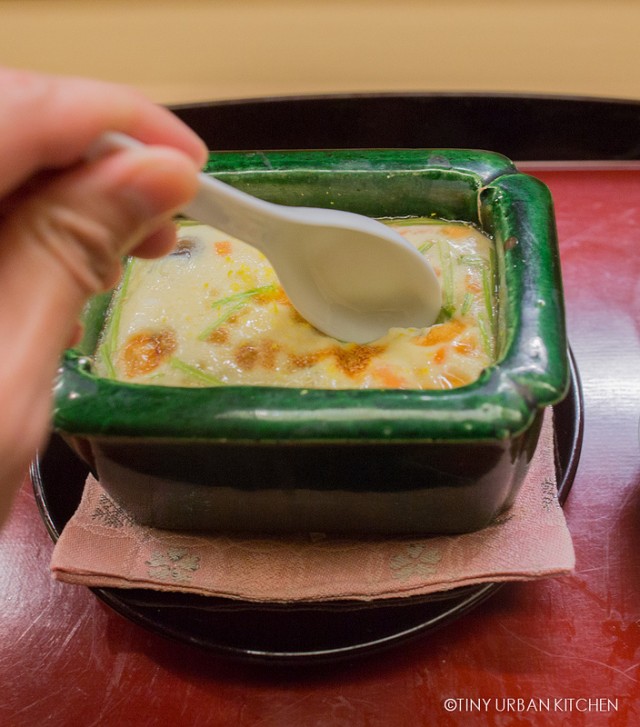
The final main savory course was an Anago (sea eel) Baked Custard with Lilly Bulb, Carrots, Shimeji Mushrooms, Mistuba Herb, and Yuzu. The custard was very light and delicate, reminding me of the steamed Japanese egg custard chawanmushi. The custard was only lightly salted, giving you an opportunity to really taste delicate nuances of all the seasonal ingredients inside.
Finally (I was sooo full at this point), they brought over a HUGE bowl of Steamed Rice brimming with Matsutake Mushrooms, Mitsuba Herbs, and Yuzu. I was so sad that I was so full. I sampled just a tiny bite.
I was so surprised when the chef offered to wrap the rest up for me to take home. 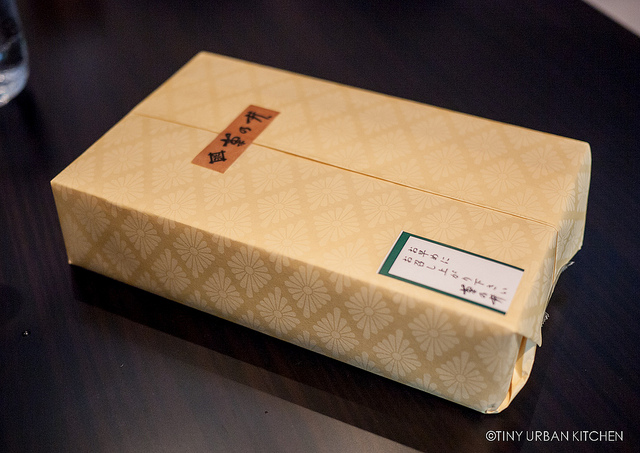 He wrapped it up so nicely, it was like I was taking a gift home. I'm so glad that 1) we had a refrigerator in the hotel room and 2) I was able to eat more of the rice at the airport on my way back to Boston.
He wrapped it up so nicely, it was like I was taking a gift home. I'm so glad that 1) we had a refrigerator in the hotel room and 2) I was able to eat more of the rice at the airport on my way back to Boston.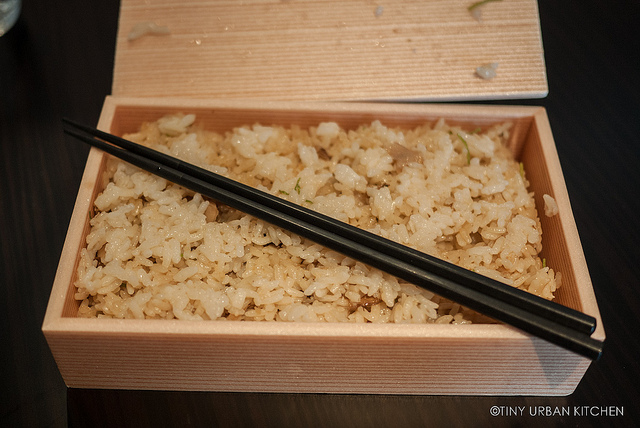 Yum!
Yum! 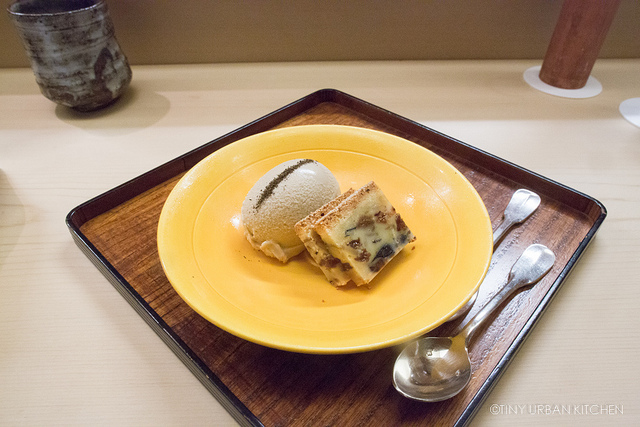
Finally, for dessert, I had Hojicha (Roasted Green Tea) Ice Cream with a Rum-Raisin-Fig cake. The tea ice cream was the best part, full of that strong, roasted tea flavor. The cake was dense, cold, and only OK (reminded me of fruitcake a little).
General Notes
This place is really, really hard to find on foot. I took the subway to Akasaka (cute neighborhood, by the way) and then tried walking to the location, using my phone GPS as my navigation guide. Even though I was almost standing right on top of the restaurant, it still took me about 15 minutes of wandering before I could find how to get in. It turns out the entrance is in a back alley, down a dark, bamboo-lined path (see top picture). Perhaps if you take a cab it will drop you right in front!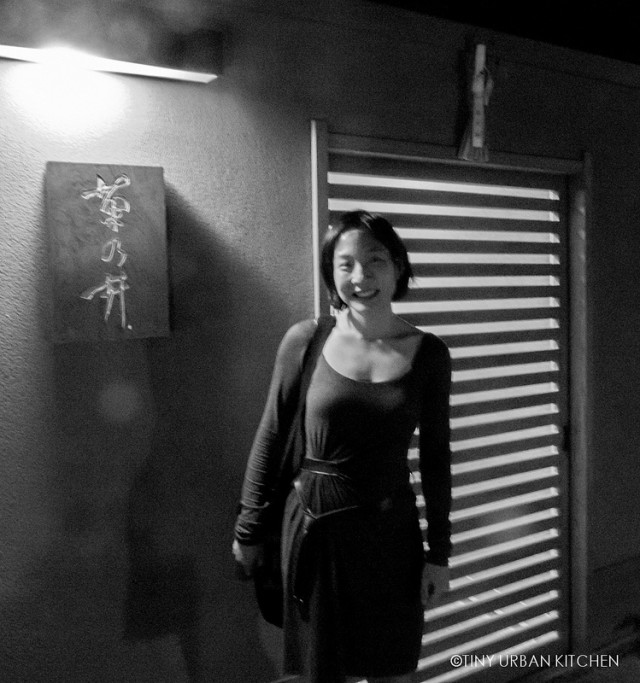
Service here is excellent, and the staff took really good care of me. On my way out, they offered to take a picture of me at the door. One of the chefs also walked with me down the dark, wooded path until I got the the lit road just to make sure I was OK.
As for the food, it was good, but I'm not sure if I would come back. Sure, there were some dishes that I loved, such as the Matsutake Soup, Matsutake rice, and the gingko beans. However, there were many other dishes that I only thought were good, but not mind-blowing. I also thought the food portions were way too big, and that affected my enjoyment of the entire experience near the end.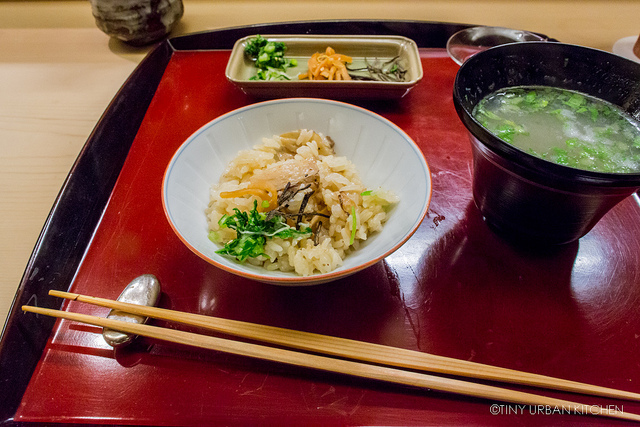 Overall, however, it was a fascinating experience. I loved the focus on seasonal ingredients and the artistry of the food was really an integral part of the entire meal. I learned I love fall ingredients, especially Matsutake mushrooms and gingko beans.
Overall, however, it was a fascinating experience. I loved the focus on seasonal ingredients and the artistry of the food was really an integral part of the entire meal. I learned I love fall ingredients, especially Matsutake mushrooms and gingko beans.
This is only my first kaiseki experience, so jury's still out on what I think of the cuisine style as a whole. In general, their raw fish dishes aren't as good as those from the top sushi places. However, I do enjoy the interesting variety of cooking methods and flavors.
Can't wait to try more!
All Rights Reserved

